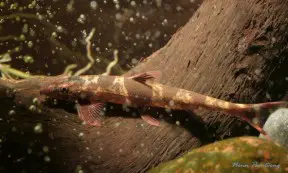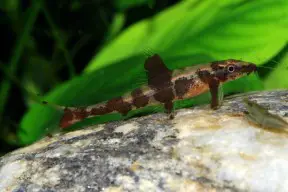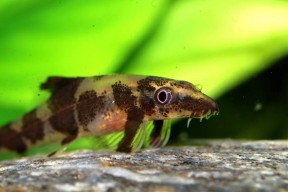Homaloptera ogilviei
Etymology
Homaloptera: From the Greek homalos (= flat, level or even) and ptera (= wing), a reference to the horizontal positioning of the pectoral and ventral fins.
ogilviei: Named for Charles S. Ogilvie, former Superintendent of the King George V National Park, Peninsular Malaysia.
Classification
Order: Cypriniformes Family: Balitoridae
Distribution
Type locality is ‘Jelai River, at 14th mile along the Tampin to Kuala Pilah Road, Negri Sembilan, Malaysia’, and this species has beenr recorded throughout much of the Malay Peninsula in both Malaysia and southern Thailand.
Habitat
An obligate dweller of flowing streams and headwaters containing clear, oxygen-saturated water. It’s often found close to riffles and runs but in slower-moving stretches among aquatic plants, submerged roots and driftwood, or leaf litter.
In the Kahang River, part of the Endau drainage, it occurs sympatrically with Homaloptera zollingeri, H. nebulosa, H. parclitella and H. tweediei as well as Malayochela maassi, Crossocheilus langei, Cyclocheilichthys apogon, Mystacoleucus marginatus, Rasbora dusonensis, R. elegans, R. paucisqualis, Trigonopoma gracile, ‘Puntius‘ partipentazona, Nemacheilus masyae, N. selangoricus, Neohomaloptera johorensis, Acanthopsoides molobrion, Pangio cuneovirgata, P. doriae, P. kuhlii, P. malayana, P. piperata, P. shelfordii, Pseudomystus fuscus, Akysis microps, A. hendricksoni, and an unidentified species of Glyptothorax.
Maximum Standard Length
45 – 50 mm.
Aquarium SizeTop ↑
An aquarium with base dimensions of 60 ∗ 30 cm or equivalent is required for long-term maintenance.
Maintenance
Most importantly the water must be clean and well-oxygenated so we suggest the use of an over-sized filter as a minimum requirement. Turnover should ideally be 10-15 times per hour so additional powerheads, airstones, etc., should be employed to achieve the desired flow and oxygenation if necessary.
Base substrate can either be of gravel, sand or a mixture of both to which should be added a layer of water-worn rocks and pebbles of varying sizes.
Driftwood roots and branches are also suitable and aquatic plants from adaptable genera such as Microsorum, Crinum and Anubias spp. can also be included. The latter are particularly useful as Homaloptera spp. appear to enjoy resting on their leaves.
Since it needs stable water conditions and feeds on biofilm this species should never be added to a biologically immature set-up, and a tightly-fitting cover is necessary since it can literally climb glass. While regular partial water changes are essential aufwuchs can be allowed to grow on all surfaces except perhaps the viewing pane.
Water Conditions
Temperature: 20 – 25.5 °C
pH: 6.0 – 7.5
Hardness: 18 – 215 ppm
Diet
Homaloptera spp. are specialised grazers feeding on biofilm, small crustaceans, insect larvae and other invertebrates.
In captivity some sinking dried foods may be accepted but regular meals of live or frozen Daphnia, Artemia, bloodworm, etc., are essential for the maintenance of good health, and it’s highly preferable if the tank contains rock and other solid surfaces with growths of algae and other aufwuchs.
Balitorids are often seen on sale in an emaciated state which can be difficult to correct. A good dealer will have done something about this prior to sale but if you decide to take a chance with severely weakened specimens they’ll initially require a continual, easily-obtainable source of suitable foods in the absence of competitors if they’re to recover.
Behaviour and CompatibilityTop ↑
Not an aggressive fish although its particular requirements limit the choice of suitable tankmates. Species inhabiting similar environments include Barilius, Discherodontus, Garra, Devario, some Rasbora, gobies of the genera Rhinogobius, Sicyopterus and Stiphodon plus Glyptothorax, Akysis and Oreoglanis spp. catfishes.
Many loaches from the family Nemacheilidae and most from Balitoridae are also suitable although harmless squabbles may occur with the latter group in particular. Research your choices before purchase to be sure.
It’s found living in aggregations in nature so buy six or more to see it at its best as when kept singly, in pairs or trios it’s less bold. The interaction between individuals is also interesting to watch and a group will typically arrange themselves close to one another facing directly into the water flow at certain times of day.
Sexual Dimorphism
Sexually mature females are usually a little larger and fuller-bodied than males.
Reproduction
Presumably a seasonal spawner in nature but nothing has been recorded in aquaria.
NotesTop ↑
H. ogilviei is quite rare in the aquarium trade but sometimes imported as bycatch among shipments of other species. On the infrequent occasions that it’s available in numbers it tends to be sold as ‘lizard’ or ‘gecko’ loach.
It can be told apart from congeners by the following combination of characters (adapted from Alfred, 1967, and Roberts, 1989): pale pinkish-brown with irregular dark markings, the largest of which forms a saddle-shape over the dorsal surface and and extends into the dorsal-fin; paired fins orientated ventrally/vertically; dorsal-fin origin anterior to pelvic-fin origin; pectoral fins with 10-13 rays, not reaching pelvic fins; pelvic fins with 2 simple and 6-7 branched rays, reaching anus; 56-61 lateral-line scales 56-61; 20 caudal peduncle scales; ventral surface scaleless to base of pelvic fins; eye diameter fits 4.5-6.1 times in head length; of caudal peduncle 13.0-18.4 in standard length.
The reason that the paired fins are orientated vertically, as opposed to horizontally in other members of the genus, is unclear but Roberts (1989) suggest it may be an adaptation to this species’ ecology, in that it displays a preference for submerged vegetation or woody structures as opposed to rocky environments.
They’re certainly adapted for a reason as in aquaria the fish are observed to perch on the tips of the pectoral, pelvic, anal, and caudal fins when at rest.
The genus Homaloptera van Hasselt, 1823 has long been considered a polyphyletic assemblage (Kottelat, 1998), and following Randall & Page (2015) the majority of members have been moved into other genera as recognized therein:
Homalopteroides Fowler, 1905 with 11 species (Homalopteroides wassinkii, H. modestus, H. rupicola, H. smithi, H. stephensoni, H. weberi, H. tweediei , H. indochinensis, H. nebulosus, H. yuwonoi, and H. avii), is the most diverse and widely distributed genus of species formerly in Homaloptera. It is known from northeast India, Myanmar, Thailand, Laos, Cambodia, Vietnam (? see Kottelat 2012:51), Peninsular Malaysia, Sumatra, Java, and Borneo.
Homalopterula Fowler, 1940 is only known to occur in Sumatra and consists of six species, five described from Aceh Province (H. heterolepis, H. ripleyi, H. modiglianii, H. amphisquamata, and H. vanderbilti) andH. gymnogaster from Sumatera Barat province.
Balitoropsis Smith, 1945 contains two species, B. zollingeri and B. ophiolepis. The original type species B. bartschi (Smith, 1945) is now considered synonymous with B. zollingeri.
Pseudohomaloptera Silas, 1953, which has not been valid since 1953, now contains six species (P. tatereganii, P. sexmaculata, P. leonardi, P. yunnanensis, P. vulgaris, and P. batek) and is known to occur in southern China, Thailand, Laos, Cambodia, Peninsular Malaysia, and Borneo.
Ghatsa Randall & Page, 2015, contains the type species G. montana Herre, 1945, and four tentatively assigned species (G. pillaii, G. menoni, G. santhamparaiensis, and G. silasi).
Homaloptera van Hasselt, 1823, consists of six species (H. ocellata [type species], H. bilineata, H. orthogoniata, H. ogilviei, H. confuzona, and H. parclitella) found in Myanmar, Thailand, Cambodia, Peninsular Malaysia, Sumatra, Java, and Borneo.
Homaloptera is distinguished by the following combination of characters: reddish tints on fins in life; dorsal-fin origin anterior to pelvic-fin origin; 7–8½, 8½ (M) branched dorsal-fin rays; 7 branched pelvic-fin rays; forked caudal fin; keeled scales; 20–27 predorsal scales; 59–73 total lateral-line scales; no adipose keel on caudal peduncle; anus closer to anal-fin origin than to pelvic-fin insertion; large rostral cap; 2 thick rostral barbels in close proximity to each other; thick triangular upper lip; fleshy pad between lateral portions of lower lip; absence of central furrow at isthmus.
All Homaloptera spp. make fascinating aquarium inhabitants and are often referred to as ‘lizard’ loaches due to their behaviour and appearance. Like all balitorids they have morphology specialised for life in fast-flowing water, i.e., the paired fins are orientated and extended horizontally, head and body flattened, belly depressed.
These features form a powerful sucking cup which allows the fish to cling tightly to solid surfaces. The ability to swim in open water is greatly reduced and they instead appear to crawl and hop their way over rocks and other surfaces.
The family Balitoridae as recognised by Kottelat (2012) is widely-distributed across much of the Indian subcontinent, Southeast Asia and China.
References
- Alfred, E. R., 1967 - Copeia 1967(3): 587-591
Homaloptera ogilviei, a new species of homalopterid fish from Malaya. - Kottelat, M., 2012 - Raffles Bulletin of Zoology Supplement 26: 1-199
Conspectus cobitidum: an inventory of the loaches of the world (Teleostei: Cypriniformes: Cobitoidei). - Kottelat, M., 2000 - Journal of South Asian Natural History 5(1): 37-82
Diagnoses of a new genus and 64 new species of fishes from Laos (Teleostei: Cyprinidae, Balitoridae, Bagridae, Syngnathidae, Chaudhuriidae and Tetraodontidae). - Kottelat, M., 2013 - Raffles Bulletin of Zoology Supplement 27: 1-663
The fishes of the inland waters of southeast Asia: a catalogue and core bibliography of the fishes known to occur in freshwaters, mangroves and estuaries. - Randall, Z. S. and L. M. Page, 2012 - Zootaxa 3586: 329-346
Resurrection of the genus Homalopteroides (Teleostei: Balitoridae) with a redescription of H. modestus (Vinciguerra 1890). - Randall, Z.S. and L.M. Page, 2015 - Zootaxa 3926, Vol 1: 57-86
On the paraphyly of Homaloptera (Teleostei: Balitoridae) and description of a new genus of hillstream loaches from the Western Ghats of India - Roberts, T. R., 1989 - Memoirs of the California Academy of Sciences 14: 1-210
The freshwater fishes of Western Borneo (Kalimantan Barat, Indonesia). - Tan, H. H. and P. K. L. Ng, 2005 - Ichthyological Exploration of Freshwaters 16(1): 1-12
Homaloptera parclitella, a new species of torrent loach from the Malay Peninsula, with redescription of H. orthogoniata (Teleostei: Balitoridae). - Tang, Q., H. Liu, R. Mayden and B. Xiong, 2006 - Molecular Phylogenetics and Evolution 39(2): 347-357
Comparison of evolutionary rates in the mitochondrial DNA cytochrome b gene and control region and their implications for phylogeny of the Cobitoidea (Teleostei: Cypriniformes). - Šlechtová, V., J. Bohlen and H. H. Tan, 2007 - Molecular Phylogenetics and Evolution 44(3): 1358-1365
Families of Cobitoidea (Teleostei; Cypriniformes) as revealed from nuclear genetic data and the position of the mysterious genera Barbucca, Psilorhynchus, Serpenticobitis and Vaillantella.






